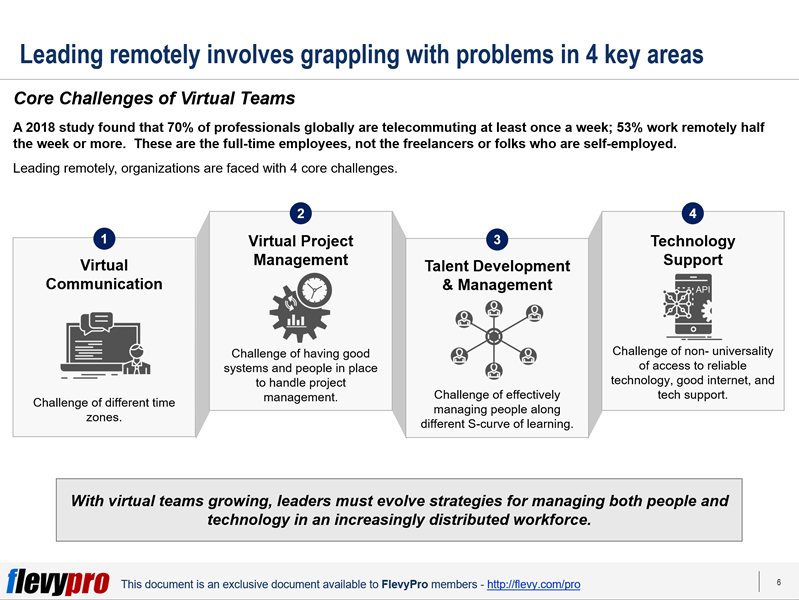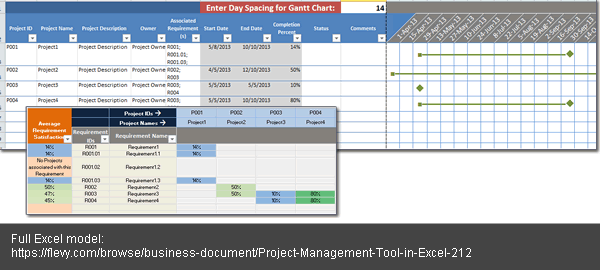
 Become a PowerPoint Guru by Dave Tracy
Become a PowerPoint Guru by Dave Tracy
Learn the methodologies, frameworks, and tricks used by Management Consultants to create executive presentations in the business world.

 Become a PowerPoint Guru by Dave Tracy
Become a PowerPoint Guru by Dave Tracy
 Initiatives aimed at improving performance are often launched with great uproar, costing an organization significant investments. Such initiatives necessitate extensive changes in the Organizational Culture and the way the enterprise systems and processes function.
Initiatives aimed at improving performance are often launched with great uproar, costing an organization significant investments. Such initiatives necessitate extensive changes in the Organizational Culture and the way the enterprise systems and processes function.
However, most initiatives fall short of realizing success. Decades of scholarly research on Change Management reveals that the issues that contribute the most to the failure of strategic initiatives are:
Researchers have carried out scores of studies to isolate the drivers of lasting change. Research published in MIT SMR in 2005 discusses how leadership can design and execute Transformation initiatives that bring lasting changes in the organization. The study entailed in-depth analysis of the strategic Customer Service Enhancement (CSE) initiative undertaken by a large clothing retailer, having franchises in multiple geographic locations.
The researchers conducted 20 semi-structured interviews with leaders, in-store operations and support function managers. Detailed notes of the interviews were shared amongst the researchers alongside an exhaustive literature review. A case study of the initiative was prepared using independent research to have an unprejudiced viewpoint, free from any bias. Feedback from the organization’s management was gathered and incorporated throughout the study to seek clarifications or corrections. Data analysis was carried out employing a coding scheme developed using Atlas.ti tool. Comparative analysis was conducted and similarities and differences in conclusions were discussed.
The study brought to light 4 key processes necessary for change to stick in an organization. These key processes assist in laying the foundation for successful institutionalization of change initiatives by creating a company-wide culture that encourages enduring change:
Let’s delve deeper into the first 2 processes.
Chartering is a process through which an enterprise classifies the purpose, scope, and the way people interact with each other on a strategic initiative. Clear delineation of project boundaries, resources, responsibilities, and reporting lines are the elements integral for the success of a change initiative.
The Chartering process entails 2 critical components:
Boundary Setting involves the key steps a team takes for accurate definition of change initiative’s scope.
The project team should clearly outline the problem(s) that the project is, and isn’t, going to tackle. Ideally, while designing and executing a change initiative, the focus of the engagement should be on confronting the most crucial problem area. The leadership should ensure not to confuse the core team by eyeing too many priorities to deal with through the strategic initiative.
The Team Design element of Chartering involves ascertaining the roles, accountabilities, and guiding principles for team’s collaboration. Team design entails creating ground rules for team members to interact, devising mechanisms to manage conflicts. The leadership needs to not only maintain diversity of the project team’s expertise, but also ensure they complement each other, and inculcate a standardized approach to decision making in project teams. There needs to be fostered a culture of positive discourse and testing ideas amongst the team members. Incorporating these guidelines helps spark thinking, learning, and decision making.
Learning aids in anticipating and dealing with hurdles during implementation of Transformation initiatives. Learning enables the managers to improve the quality of the new processes. it is a process through which managers develop, test, and refine ideas before full-scale implementation. The process entails 2 critical components:
The discovery element involves gathering data to identify the objectives of the change initiative and outlining ways to achieve those objectives. Before rolling out a complete implementation of a change initiative, testing and refining the individual elements of the initiative immensely assists in the success of the initiative. Gathering adequate information relevant to the initiative, setting up baseline metrics to measure performance, and identifying issues hampering customer satisfactions are the key aspects of this phase. The team should learn from the failures of prior initiatives, introduce change in a systemic fashion rather than piecemeal, and encourage people to change rationally as well as emotionally.
Interested in learning more about the other processes critical for change to stick? You can download an editable PowerPoint on 4 Processes of Sustainable Change here on the Flevy documents marketplace.
You can download in-depth presentations on this and hundreds of similar business frameworks from the FlevyPro Library. FlevyPro is trusted and utilized by 1000s of management consultants and corporate executives. Here’s what some have to say:
“My FlevyPro subscription provides me with the most popular frameworks and decks in demand in today’s market. They not only augment my existing consulting and coaching offerings and delivery, but also keep me abreast of the latest trends, inspire new products and service offerings for my practice, and educate me in a fraction of the time and money of other solutions. I strongly recommend FlevyPro to any consultant serious about success.”
– Bill Branson, Founder at Strategic Business Architects
“As a niche strategic consulting firm, Flevy and FlevyPro frameworks and documents are an on-going reference to help us structure our findings and recommendations to our clients as well as improve their clarity, strength, and visual power. For us, it is an invaluable resource to increase our impact and value.”
– David Coloma, Consulting Area Manager at Cynertia Consulting
“FlevyPro has been a brilliant resource for me, as an independent growth consultant, to access a vast knowledge bank of presentations to support my work with clients. In terms of RoI, the value I received from the very first presentation I downloaded paid for my subscription many times over! The quality of the decks available allows me to punch way above my weight – it’s like having the resources of a Big 4 consultancy at your fingertips at a microscopic fraction of the overhead.”
– Roderick Cameron, Founding Partner at SGFE Ltd
Richard Branson, British business and philanthropist once said: “One day, offices will be a thing of the past.”
While organizations still need to travel to reach their physical offices, the rapid changes in the world are requiring business
Virtual Teams work well for an organization and is effective even from a communication perspective. In fact, it is known to complement well the Lean Management approach used by organizations. Studies from previous years have shown that well-managed, widely spread, Virtual Teams have been outperforming those that share office space. In fact, it has shown that using Virtual Teams can improve employee productivity by 45%.es to form Virtual Teams. A Virtual Team refers to a group of individuals who work together from different geographic locations and rely on communication technology such as email, voice conferencing services, fax, etc.
In today’s highly competitive global economy, to be able to work smarter, organizations must be able to leverage the manifold benefits of a remote workforce. Likewise, organizations must also be able to manage challenges that come with working with Virtual Teams.
More organizations are opting to work with virtual teams. Virtual teams may have their benefits but it also has its challenges. Being able to manage these challenges will enable organizations to seize the benefits of remote workers.

There are 4 core challenges that organizations face when working with Virtual Teams. Let us take a look at the 2 core challenges.
In this digital era, Virtual Teams are becoming the new face of business operation and aligning itself with Digital Transformation. This is a global reality that businesses must accept. However, working with Virtual Teams brings a lot of challenges not only in Project Management and Virtual Communication but also in Talent Development and Technology Support. Talent Development and Technology Support are two other core challenges that can make an impact on the Virtual Team. How it is managed will define the success of your Virtual Team.
In hindsight, Virtual Teams can also bring so many benefits. Hence, it is not surprising that despite the challenges, a lot of businesses still prefer to work with Virtual Teams.
One core benefit is increased access to top talent. The world has become a global market for expertise and talents. Businesses can extend their reach to other countries in their search for needed expertise. In fact, working with virtual teams will open opportunities for businesses to work with experts in various fields with various experiences. Being able to employ the best and the brightest is more than enough for businesses to continue working with Virtual Teams and conquering challenges. Businesses just need to have appropriate support programs to give Virtual Teams a home-field advantage.
Interested in gaining more understanding of the challenges & benefits of Virtual Teams? You can learn more and download an editable PowerPoint about Virtual Teams: Challenges & Benefits here on the Flevy documents marketplace.
Are you a management consultant?
You can download this and hundreds of other consulting frameworks and consulting training guides from the FlevyPro library.
In 2012, Ron Leeman was awarded Change Leader by the World HRD Congress. He has published over 10 frameworks to Flevy, including a Comprehensive Guide to Change Management.
This 191-slide deck contains everything (well almost) you would ever want to know about Change Management. It includes What is Change Management, Change Management vs Project Management, The Challenge of Change, Change Management Models, Ways of Implementing Change, People and Change, Managing Change Resistance, Change Behaviours, The head/Heart/Soul of Change, Change Agents, The Tools & Techniques of Change (inc. Sponsorship, Stakeholder Management and Engagement, Communication, Process Change, Organisational Change, Training, Adoption and Business Readiness, Business Benefits & Continuous Improvement), A Change Story and Success and Failure.
Here is a partial preview.
View all of Ron’s documents on Flevy here.
Here are 4 powerful tools and frameworks for Project Management available on Flevy.
PRINCE2 Project Management Overview
https://flevy.com/browse/business-document/prince2-project-management-overview-287
This document is a 77-slide PowerPoint presentation that provides a Project Management Overview based on the PRINCE2 methodology that has been recognised world-wide as the leading Best Practice framework for successful project execution. The document is easily customisable, content can be removed (or simply skipped over during presentation), and additional slides can be added to provide more subject depth.
Project Management Social
https://flevy.com/browse/business-document/project-management-social-921
Helps project management practitioners as well as project management companies to understand the value of social media and how to integrate it onto projects. This document is full of examples based on research, training about different social media platforms and tools and very practical advice that can be applied immediately to compile your own customized strategy for how to use social media on your projects. This 32-page deck also includes an accompanying Social Media Strategy template (Word document).
Consulting Project Management Survival Guide
https://flevy.com/browse/business-document/consulting-project-management-survival-guide-648
A guide to Project Management for management consultants. Includes a breakdown of Key Success Factors and KPIs for project managers.
Project Management Workbook (Excel)
https://flevy.com/browse/business-document/project-management-workbook-436
This Excel workbook is an alternate to using the often-too-cumbersome MS Project. Allows you both to track and monitor project activities.
Looking for tools and resources for any other business project? Take a look at Flevy’s 40+ end-to-end Business Toolkits:
Project topics include Balanced Scorecard, Cost Reduction, Six Sigma, Pricing Strategy, Value Chain Analysis, among others.
Project Management can be a headache. It involves keeping track of deadlines, status updates, risks, urgent issues, resources, timelines, competing priorities, budgets, among other things.
Microsoft Project is the software used by most project managers. Unfortunately, MS Project is difficult software to work with, due to its slow speed, lack of compatibility with other Office products, and poor user interface.
This past week, an Excel-based Project Management Tool has been released on Flevy. This new Excel project management model presents numerous benefits over MS Project. It’s a better and easier way of performing the cumbersome task of project management.
The creator of the tool is a seasoned consultant from a Big 4 consulting firm. He states that “about a year ago, I got so frustrated with Microsoft Project, I decided to start working with Excel. It more than sufficiently satisfies the basic requirements of any project management tool. Excel is also far more customizable and compatible than Microsoft Project, allowing me to build reports and share my work more easily with others.”
View and download the tool here:
https://flevy.com/browse/business-document/Project-Management-Tool-in-Excel-212

This model has the following features:
It can be said the biggest benefit of this Excel project management tool over Microsoft Project is the ability to fully customize the Excel model to fit any project’s specific needs.
Flevy is a marketplace for business strategy frameworks, PowerPoint templates, financial models, business presentations, market research reports, and other premium business documents. Download documents to expedite your projects or upload documents to generate passive income.
Questions, thoughts, concerns? Go to my site (learnppt.com) and shoot me an email.
For pre-made PowerPoint diagrams used in business presentations and other powerpointing needs, browse our library here: learnppt.com/powerpoint/. These diagrams were professionally designed by management consultants. Give your presentations the look and feel of a final product made by McKinsey, BCG, Bain, Booz Allen, Deloitte, or any of the top consulting firms.
Error: Twitter did not respond. Please wait a few minutes and refresh this page.